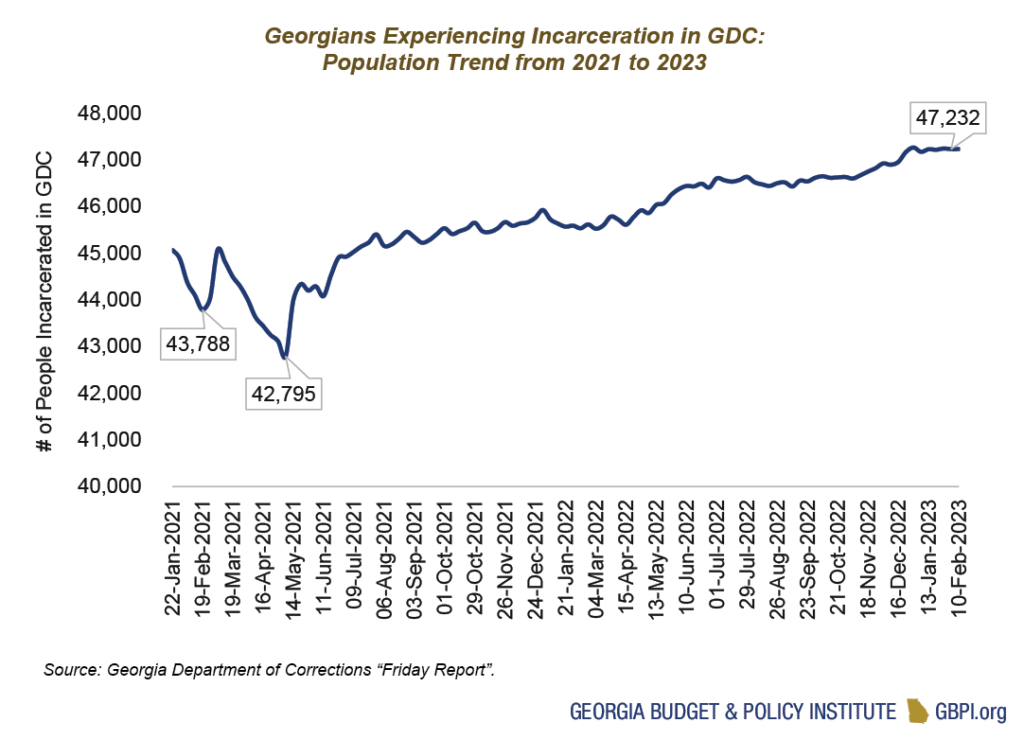For Fiscal Year (FY) 2024, Gov. Brian Kemp proposed a $1.32 billion budget for the Georgia Department of Corrections (GDC), an agency charged with overseeing the state’s prison system. These latest fiscal- year-to-fiscal-year increases, totaling nearly $38 million, are primarily attributed to the creation of four new divisions within the GDC: County Correctional Institutions, Engineering and Construction Services, Investigations and Interdiction, and Rehabilitation and Risk Reduction. In tandem with intensifying “law and order” proposals from the legislature, these latest moves are ominous steps toward future corrections budget proposals that will lead to rising prison populations.
While criminal justice reforms under the Deal administration sought to reduce the length of incarceration while expanding probation and parole eligibility, legislative, programmatic and agency changes under Kemp’s administration have been made alongside rising prison populations. The decline in Georgia’s state prison population, due in part to pandemic-fueled statewide court case delays, brought the population under 43,000. As criminal legal system processes have resumed pre-pandemic activity, Georgia’s prison population growth has also resumed, reaching more than 47,000 by January 2023. The recent growth over 2022 is a result of increases in two of the state’s carceral sub-populations: Georgians in state prisons and those in transitional centers.[1]

While representing only 32.6 percent of Georgia’s population, Black Georgians make up 59 percent of the GDC’s prison population.[2] Georgia’s legacy of slavery, segregation, Jim Crow, racialized criminalization through over-policing in communities of color, racially biased school punishment and historic disinvestments in communities of color have all contributed to the overrepresentation of the state’s Black residents in prison. Racial equity as a key budget policy goal has yet to permeate discussions around the inequities and disparate impacts of Georgia’s criminal legal system.
Following the previous period of proposals to increase corrections spending from FY 2022 to FY 2023, Gov. Kemp proposes to raise corrections spending for the second consecutive year (increases from FY 2023 to FY 2024). For FY 2024, the GDC has proposed spending increases that give $2,000 cost-of-living adjustment (COLA) increases to full-time eligible staff, transferred funding and staff positions to accommodate four new GDC divisions, increased funds for physical health and pharmacy services contracts, and redirected funds to close or reconfigure some prison operations while opening McRae state prison for women. Overall, the GDC’s budget for FY 2024 totals $1.32 billion, which reflects a nearly $38 million increase from the previous fiscal year’s spending level.
By the Numbers
Amended 2023 Fiscal Year Budget
These amended changes would increase the current FY 2023 budget by $42.9 million and serve as a FY 2022 to FY 2023 increase of nearly $154 million. Amended FY 2023 changes also include:
- $12.3 million to increase funds for physical health and pharmacy services contracts
- Across 19 prison facilities:
- $32.5 million for maintenance and renovation projects
- $15 million to upgrade life safety and security systems
- $4 million for emergency repairs
- Reducing and redirecting $20.9 million to reflect the closure of Georgia State Prison
2024 Fiscal Year Budget
- Transferring $202 million from existing programs, for budgetary alignment and ancillary support for the creation of four new GDC divisions
- Of that transferred $202 million, allocating $151 million to directly fund the creation of four new GDC divisions
- $25.7 million to fund the opening of McRae prison for women
- $21.8 million for $2,000 pay raises to full-time, benefit-eligible staff
- $18.7 million to close Lee Arrendale State Prison, to reflect cessation of operations as a women’s prison
- Reallocating $561,000 to maintain Lee Arrendale facility as a Transition Center
Despite nearly $81 million in proposed added spending over the course of AFY 2023 and FY 2024, these priorities do not reduce the additional multi-million-dollar financial burden placed on Georgians experiencing incarceration and the loved ones who support them. They carry the additional burden of a more-than-$5 million FY 2021 cut that was achieved by increasing commissary prices. This will continue to make necessities, including hygiene products, much more difficult to access for those who are experiencing incarceration, as well as for the families who support them.
This added spending also fails to account for how GDC appropriates for humane accommodations for the varied, rising and specific needs incarcerated women and birthing people experience—including postpartum pumping rooms, lactation programs and child-friendly spaces for children visiting parents experiencing incarceration. Additionally, the added spending does not outline any present programs that provide formal training to unpaid incarcerated workers, who generate millions, if not billions of dollars of revenue for GDC, other state agencies and for private sector firms across the state.
As 2022-to-present GDC population trends signal a post-pandemic uptick, fiscal policy shifts that drive those trends show little sign of changing course. Rising incarceration requires a more supportive prison infrastructure. The growth of local government incarceration infrastructure, including the establishment of the new County Correctional Institutions program,[3] deepens the incentives for local government financial and operational dependence on incarceration.
Rising prison populations, and the revenue generated from incarcerated Georgians and their loved ones, sow state and local dependence on forcible, regressive revenue.[4] These fiscal approaches, paired with legislative approaches that focus solely on punishment or which magnify racist tropes, will only worsen suffering that Georgians of color disproportionately experience.
End Notes
[1] Georgia Department of Corrections. (2023, February 10). Friday report. Retrieved February 16, 2023, from https://gdc.ga.gov/sites/default/files/FridayReport-2023_02_10.pdf
[2] Georgia Department of Corrections. (2023, January). Profiles of all inmates report. Retrieved February 16, 2023, from https://gdc.ga.gov/sites/default/files/pdf/profile_rpt_Profile_all_inmates_2023_01.pdf
[3] Per the Governor’s Budget Report for AFY 2023 and FY 2024, the new County Correctional Institutions program will serve the purpose of contracting with Georgia counties to provide cost-effective prison facilities that ensure public safety.
[4] Khalfani, R. (2022, December 6). Regressive revenue perpetuates poverty: Why Georgia’s fines and fees need immediate reform. Georgia Budget and Policy Institute. https://gbpi.org/regressive-revenue-perpetuates-poverty-why-georgias-fines-and-fees-need-immediate-reform/









